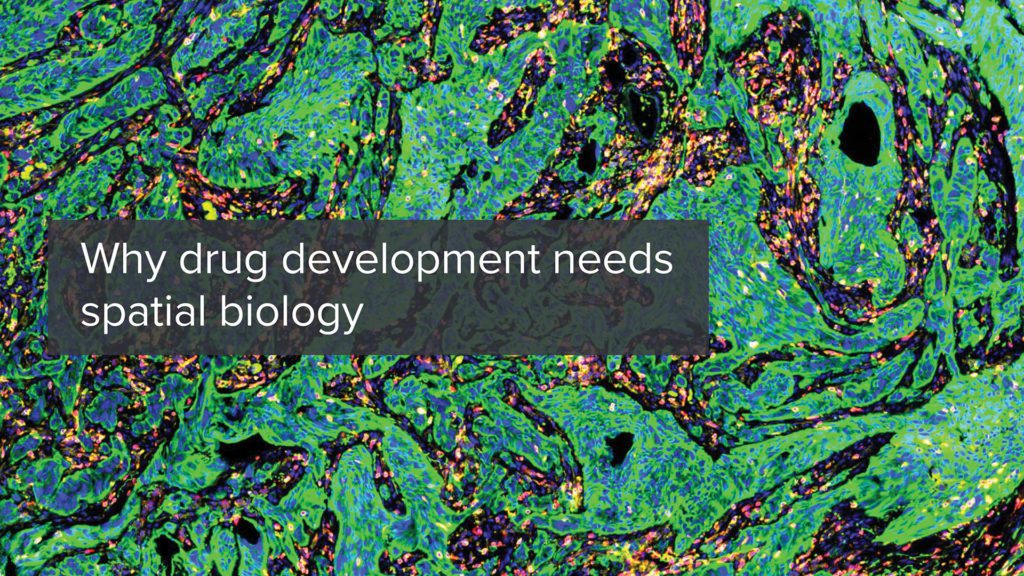August 13, 2024
Why drug development needs spatial biology
Understanding how drug candidates interact within diverse cellular environments and how these interactions translate to patient outcomes can be challenging. Moreover, heterogeneity within seemingly uniform diseases can lead to varied treatment responses, complicating the path to truly personalized therapies. As the field grapples with these challenges, new methodologies are needed to unravel the intricacies of disease and drug response. To this end, attention is increasingly turning to spatial biology.
What is spatial biology?
Spatial biology is the study of cells within their native environments. Unlike traditional bulk approaches, spatial biology preserves the spatial context, allowing scientists to study how cells and molecules are distributed and interact within complex tissues and the architectural changes associated with various biological processes and diseases. By leveraging these insights, spatial biology enhances the understanding of drug effects at the cellular level, aiding the development of targeted therapies.
While spatial biology is not a new concept recent advances in multiplexing have transformed the field. These innovations enable the simultaneous measurement of multiple markers, and with enhanced computational capabilities, we can more effectively analyze the relationships between them. This deeper understanding of complex biological paradigms has elevated spatial biology into a powerful tool for drug development.
Why drug developers are turning to spatial biology
Drug developers are turning to spatial biology because it offers a deeper understanding of cellular context, leading to more accurate drug targeting, better predictions of drug efficacy, and insights into disease mechanisms.
As drug development is complex and costly, these comprehensive tools are essential for improving the efficiency of therapy development. Integrating spatial biology into drug development workflows offers several benefits:
- Aids understanding of tissue microenvironments: Spatial biology can reveal the complexities of the tissue microenvironment, leading to the identification of new therapeutic targets and treatments.
- Addresses disease heterogeneity: Spatial biology enables the examination of the cellular heterogeneity that traditional bulk methods might miss. This helps unravel how cells organize and contribute to disease progression and treatment response.
- Enables biomarker identification: Spatial biology aids biomarker identification by revealing cells’ exact location and interactions within their native tissue environments, giving a detailed view of cellular behavior and disease mechanisms.
- Enhances drug distribution and efficacy studies: Spatial biology provides insights into the pharmacodynamics and pharmacokinetics of new compounds.
- Elucidates mechanism of action: Spatial biology provides a detailed understanding of how cells interact and respond to treatments, thereby clarifying drugs’ mechanisms of action.
- Improves immune response profiling: Spatial biology enhances the ability to profile immune responses by accurately mapping the infiltration status and immune cell states within their native tissue context.
- Builds understanding of drug resistance: Spatial biology helps to unravel the mechanisms behind drug resistance by examining how cellular and tissue environments influence the effectiveness of therapies.
A discovery toolbox to accelerate drug development
Spatial biology has emerged as a groundbreaking discovery toolbox, significantly accelerating drug development by offering detailed insights into tissue microenvironments and molecular interactions. Cutting-edge platforms like Visium and Visium HD from 10X Genomics, GeoMX Digital Spatial Profiler from NanoString, and COMET from Lunaphore are at the forefront of this revolution. These platforms allow researchers to simultaneously capture high-plex RNA and protein information from a single tissue section, enabling a comprehensive understanding of cellular contexts and interactions.
Visium HD delivers high-resolution spatially resolved gene expression profiles, while GeoMX offers high-plex protein and RNA analysis powered by precise segmentation capabilities. COMET complements these with its sub-cellular resolution imaging capabilities and allows for the detailed exploration of tissue architecture and biomolecular interactions.
These tools are crucial for early clinical research as they rapidly generate valuable insights into disease mechanisms, drug efficacy, and biomarker validation.
Accelerating your drug development with spatial biology
By facilitating the exploration of complex tissue environments and enabling a deeper understanding of cellular heterogeneity, spatial biology tools streamline the path from preclinical studies to clinical application. This accelerates the identification of promising therapeutic candidates and optimizes their development, ensuring that drug developers can address key challenges more efficiently. With the path to clinical implementation becoming increasingly accessible, these advanced spatial biology platforms are poised to play a pivotal role in shaping the future of personalized medicine and therapeutic innovation.
To learn more about spatial biology and how it could help support and accelerate your therapeutic development, visit: spatial biology
About the author

İlayda Hasakioğulları is a Senior R&D Product Manager at CellCarta. Ilayda is passionate about precision medicine and specializes in spatial biology technologies. She continually scans the landscape to implement cutting-edge solutions at CellCarta and assists scientists in selecting the best tools for their research needs with the ultimate goal of benefiting patients.
You might also be interested by
CellTalk Blog
This is SPARTA: A Framework for Multiplex Immunofluorescence Analysis
November 13, 2025
More infoPosters
Artificial Intelligence-powered Spatial Analysis of Tumor Microenvironment Identifies Immune Phenotype in Non- Small Cell Lung Cancer, Colorectal Cancer and Urothelial Cancer.
October 30, 2025
More info